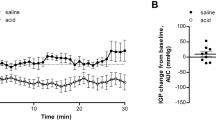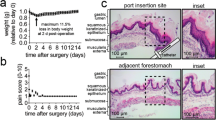Abstract
The resistance of the gastric mucosa to acid and peptic injury is reflected by a resistance to the back-diffusion of H+ from gastric lumen to blood1,2. The nature of this ‘barrier’, however, remains undefined. Using Ussing chambers, we have now studied the acid-barrier function of monolayers prepared from dispersed canine fundic chief cells3. These monolayers secrete pepsinogen in response to stimulation4. We found that, on acidification of the apical solution to pH 2, transepithelial resistance (R) increased 2.6-fold and the monolayers maintained this 1:100,000 H+ concentration gradient for more than 4 h. The addition of aspirin to the acidified apical solution caused a rapid decay in R, as did acidification of the basolateral solution to a pH < 5.5. Ouabaintreated monolayers displayed the rise in R expected with apical acidification, while potential difference (V) and short-circuit current (Isc) decreased essentially to zero, indicating impermeability to H+. However, if the integrity of the ouabaintreated monolayers was disrupted by low apical pH, H+ permeation occurred, reflected by an Isc that was dependent on the H+ gradient across monolayers. These data indicate that the apical surface of chief cells is a very tight barrier to H+ diffusion and may be an important element resisting acid-peptic injury.
This is a preview of subscription content, access via your institution
Access options
Subscribe to this journal
Receive 51 print issues and online access
$199.00 per year
only $3.90 per issue
Buy this article
- Purchase on Springer Link
- Instant access to full article PDF
Prices may be subject to local taxes which are calculated during checkout
Similar content being viewed by others

References
Davenport, H. W., Warner, H. A. & Code, C. F. Gastroenterology 47, 142–152 (1964).
Davenport, H. W. in Progress in Gastroenterology Vol. 2 (ed. Glass, G.B.J.) 42–56 (Grune & Stratton, New York, 1970).
Ayalon, A., Sanders, M. J., Thomas, L. P., Amirian, D. A. & Soll, A. H. Proc. natn. Acad. Sci. U.S.A. 79, 7009–7013 (1982).
Sanders, M. J., Amirian, D. A., Ayalon, A. & Soll, A. H. Am. J. Physiol. 245, G641–G646 (1983).
Powell, D. W. Am. J. Physiol. 241, G275–G288 (1981).
Machen, T. E., Silen, B. & Forte, J. Am. J. Physiol. 234, E228–E235 (1978).
Wright, E. M. & Diamond, J. M. Biochim. biophys. Acta 163, 57–74 (1978).
Mandel, L. J. Am. J. Physiol. 235, C35–C48 (1978).
Schiessel, R., Matthews, J., Barzilai, A., Merhav, A. & Silen, W. Nature 283, 671–673 (1980).
Flemstrom, G., Heylings, J. R. & Garner, A. Am. J. Physiol. 242, G100–G110 (1982).
Grossman, M. I. in Basic Mechanisms of Gastrointestinal Mucosal Cell Injury and Protection (ed. Harmon, J.) 323–326 (Williams & Wilkins, New York, 1981).
Rutten, M. J. & Ito, S. Am. J. Physiol. 244, G171–G182 (1983).
Soll, A.H. J. clin. Invest. 61, 370–380 (1978).
Author information
Authors and Affiliations
Rights and permissions
About this article
Cite this article
Sanders, M., Ayalon, A., Roll, M. et al. The apical surface of canine chief cell monolayers resists H+ back-diffusion. Nature 313, 52–54 (1985). https://doi.org/10.1038/313052a0
Received:
Accepted:
Issue Date:
DOI: https://doi.org/10.1038/313052a0
This article is cited by
-
Use of commercially available cell culture inserts for primary culture and electrophysiologic studies of guinea pig gastric mucous epithelial cells
Journal of Tissue Culture Methods (1992)
-
Effect of luminal acidification on guinea pig gastric mucosa
Digestive Diseases and Sciences (1992)
Comments
By submitting a comment you agree to abide by our Terms and Community Guidelines. If you find something abusive or that does not comply with our terms or guidelines please flag it as inappropriate.


